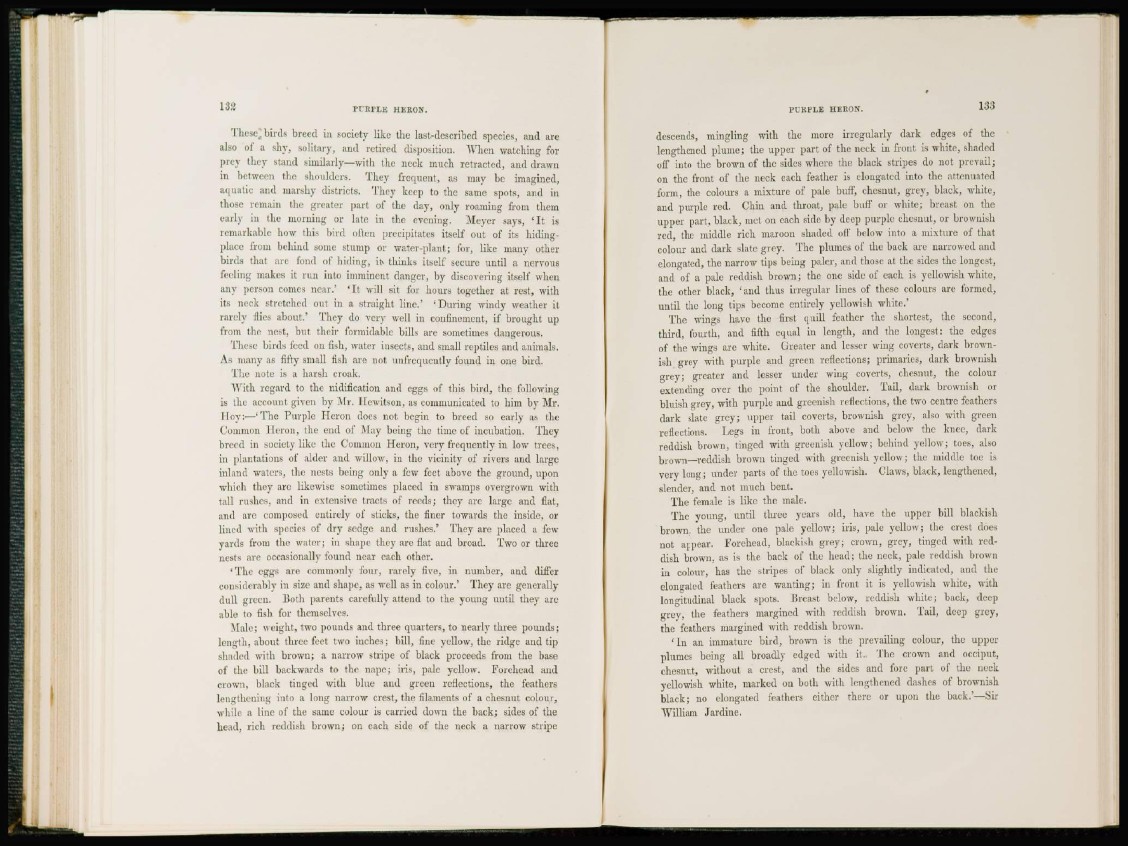
13S PURPLE HEKON.
These,; birds breed in society like the last-described species, and are
also of a shy, solitary, and retired disposition. When watching for
prey they stand similarly—with the neck much retracted, and drawn
in between the shoulders. They frequent, as may be imagined,
aquatic and marshy districts. They keep to the same spots, and in
those remain the greater part of the day, only roaming from them
early in the morning or late in the evening, Meyer says, ' I t is
remarkable how this bird often precipitates itself out of its hidingplace
from behind some stump or water-plant; for, like many other
birds that are fond of hiding, its thinks itself secure until a nervous
feeling makes it run into imminent danger, by discovering itself when
any person comes near.' ' I t will sit for hours together at rest, with
its neck stretched out in a straight line.' 'During windy weather it
rarely flies about.' They do very well in confinement, if brought up
from the nest, but their formidable bills are sometimes dangerous.
These birds feed on fish, water insects, and small reptiles and animals.
As many as fifty small fish are not unfrequenlly found in one bird.
The note is a harsh croak.
With regard to the nidification and eggs of this bird, the following
is the account given by Mr. Hewitson, as communicated to him by Mr.
Hoy:—'The Purple Heron does not begin to breed so early as the
Common Heron, the end of May being the time of incubation. They
breed in society like the Common Heron, very frequently in low trees,
in plantations of alder and willow, in the vicinity of rivers and large
inland waters, the nests being only a few feet above the ground, upon
which they are likewise sometimes placed in swamps overgrown with
tall rushes, and in extensive tracts of reeds; they are large and flat,
and are composed entirely of sticks, the finer towards the inside, or
lined with species of dry sedge and rushes.' They are placed a few
yards from the water; in shape they are flat and broad. Two or three
nests are occasionally found near each other.
' T h e eggs are commonly four, rarely five, in number, and differ
considerably in size and shape, as well as in colour.' They are generally
dull green. Both parents carefully attend to the young until they are
able to fish for themselves.
Male; weight, two pounds and three quarters, to nearly three pounds;
length, about three feet two inches; bill, fine yellow, the ridge and tip
shaded with brown; a narrow stripe of black proceeds from the base
of the bill backwards to the nape; iris, pale yellow. Forehead and
crown, black tinged with blue and green reflections, the feathers
len "I honing into a long narrow crest, the filaments of a chesnut colour,
while a line of the same colour is carried down the back; sides of the
head, rich reddish brown; on each side of the neck a narrow stripe
PURPLE HERON. 133
descends, mingling with the more irregularly dark edges of the
lengthened plume; the upper part of the neck in front is white, shaded
off into the brown of the sides where the black stripes do not prevail;
on the front of the neck each feather is elongated into the attenuated
form, the colours a mixture of pale buff, chesnut, grey, black, white,
and purple red. Chin and throat, pale buff or white; breast on the
upper part, black, met on each side by deep purple chesnut, or brownish
red, the middle rich maroon shaded off below into a mixture of that
colour and dark slate grey. The plumes of the back are narrowed and
elongated, the narrow tips being paler, and those at the sides the longest,
and of a pale reddish brown; the one side of each is yellowish white,
the other black, ' a n d thus irregular lines of these colours are formed,
until the long tips become entirely yellowish white.'
The wings have the first quill feather the shortest, the second,
third, fourth, and fifth equal in length, and the longest: the edges
of the wings are white. Greater and lesser wing coverts, dark brownish
grey with purple and green reflections; primaries, dark brownish
grey; greater and lesser under wing coverts, chesnut, the colour
extending over the point of the shoulder. Tail, dark brownish or
bluish grey, with purple and greenish reflections, the two centre feathers
dark slate grey; upper tail coverts, brownish grey, also with green
reflections. Legs in front, both above and below the knee, dark
reddish brown, tinged with greenish yellow; behind yellow; toes, also
brown—reddish brown tinged with greenish yellow; the middle toe is
very long; under parts of the toes yellowish. Claws, black, lengthened,
slender, and not much bent.
The female is like the male.
The young, until three years old, have the upper bill blackish
brown, the under one pale yellow; iris, pale yellow; the crest (hies
not appear. Forehead, blackish grey; crown, grey, tinged with reddish
brown, as is the back of the head; the neck, pale reddish brown
in colour, has the stripes of black only slightly indicated, and the
elongated feathers are wanting; in front it is yellowish white, with
longitudinal black spots. Breast below, reddish white; back, deep
grey, the feathers margined with reddish brown. Tail, deep grey,
the feathers margined with reddish brown.
' I n an immature bird, browu is the prevailing colour, the upper
plumes being all broadly edged with it. The crown and occiput,
chesnut, without a crest, and the sides and fore part of the neck
yellowish white, marked on both with lengthened dashes of brownish
black; no elongated feathers either there or upon the back.'—Sir
William Jardine.